Entrada Universitaria (Celebration of the beginning of the new semester)
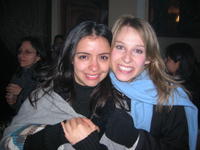
On Saturday, Sara (my host sister) and I went to the La Paz uptown (central area) and visited some museums.It was very interesting to learn more about Bolivia´s independence war and the history of the Ancient Indian civilizations that lived in the Andes before the arrival of the Spaniards.The one that was probably the most interesting was the museum dedicated entirely to the Litoral (the Bolivian province that was lost to the Chileans along with the access to the sea, which I have mentioned in one of my previous entries).It was obvious that the Bolivians are still very angry at the Chileans, and I definitely learned the reason why:the Chileans invaded this province and claimed it as their own once its riches (gold, huano) were discovered, thus breaking several treaties made with Bolivia.
Saturday was also another holiday in La Paz, called Entrada Universitaria, which celebrates the beginning of a new spring semester.All the departments of the numerous universities in La Paz rehearse traditional Bolivian dances and perform them in the city streets.It was definitely very interesting to learn more about the Bolivian culture and witness this celebration full of music, colorful costumes, and beautiful dances.The pictures below are of 2 typical Bolivian folk dances.
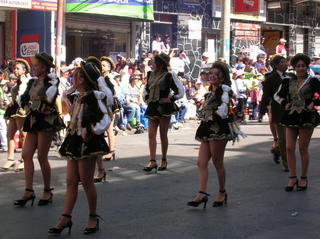
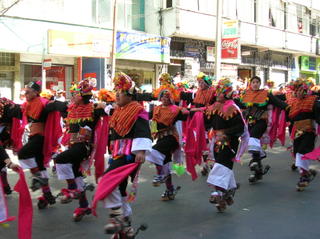
Coroico
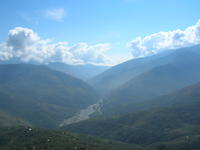
I spent Wednesday and Thursday of last week in the beautiful Coroico, a small town across the mountain range from La Paz with subtropical climate, which meant warm weather and short sleeves.I was there with the team from my church in MD (Covenant Life Church) and several people from the church here in La Paz.To get there, you have to travel along the Camino de Muerte (Road of Death), a narrow winding rocky mountain road.We stayed in an adorable quaint hotel (without hot water though)overlooking a mountain range and a valley that was filled with clouds in the mornings.I have never seen a sight like that before.We went to a waterfall, walked around the city, and of course, had fireworks (that seems to be the most common thing to do here for fun since it´s legal). The best part was getting to know the people from Covenant Life and serve together by painting a small local church.I had no idea how much detail was involved in painting, but now I feel like I can paint.
(The picture below is of me and Jen Wahl, a girl from my care group (Bible-study)at Covenant Life, by the waterfall)
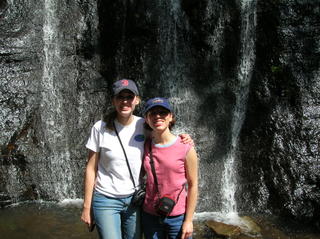
Tiwanaku (Ancient Incan Ruins)

The team from my church in Gaithersburg, Maryland is here in La Paz on a missions trip, helping in the church here, doing evangelism, and ministering in various other places.With them, I had a chance to visit the ruins of an important religious site of the ancient Inca civilization (400BC-about 1200AD), which stretched from Northern Chile, all over Peru, the Bolivian Altiplano, and even Northern Argentina and Southern Ecuador. It was very interesting to see what a high level of development the Incas had reached; from the ruins of their temples and the remains of their culture, it was evident that they had progressed in engineering, mathematics, astronomy, and architecture.They lived by three principles and always used them to greet each other:
~Don't steal
~Don't kill
~Don't be lazy
The Incas lived in constant expectation that something big would happen to them (according to their astrological predictions), and that is why when the Spaniards, white men on horses with guns,came, the Incas thought that they were gods and welcomed them into their cities, resulting in 120 Spaniards overtaking almost the entire Inca empire (I think I remember this correctly).
On the way back, we had a lot of fun sharing our testimonies and laughing at each other.It was amazing to see how God has put such different people together on this team and to hear about the evidences of God's grace in their lives.

The Day of La Paz

I feel really lucky because I got to experience one big holiday here in La Paz, July 16th, which is the Day of La Paz, and then will be here for the other big one, August 6th, the Independence Day.Well,even though the official holiday is today, yesterday most schools and offices were closed for an all-day parade...It reminded me of the Cherry Blossom Parade in DC. All the school bands were out on the streets, with banners,singing the song of La Paz, that I can probably sing by now since I heard it sooo many times yesterday.Sara (my host sister) and I went out late to watch the parade uptown and were lucky enough to make our way through the crowd of people to the main plaza and stand almost right in front of the mayor during the parade.One interesting thing about Bolivia: people are still not over the war with Chile.What happened is that Chile invaded Bolivia and in a war took away Bolivia's access to the sea.So now, even though Bolivia has 9 provinces, the parade participants were carrying 10 flags, one of which was for that lost province.The Bolivians are still very bitter about the loss, and generally dislike Chileans.

Trip to the altiplano

This week I had a chance to visit another area of Bolivia, this time a cold, windy and dry altiplano (mountaneous planes)of two departments, Oruro and Potosi.This trip was definitely different from the previous one, but even more eyeopening and interesting.
MondayThis time, I was lucky to travel in a nice Nissan SUV. After a 2-hour ride along the altiplano, we arrived in Oruro, a sad city of miners, where the only thing to see was a famous Catholic temple with an ancient mine underneath.Something really weird happened to me when I got there: I got incredibly dizzy and my throat was closing up from dryness...no amount of water was enough.After 2 hours of laying down I was fine, but it really reminded me not to discount altitude sickness (Oruro is about 200 meters higher than La Paz). That night I stayed in a cozy hotel and watched cable TV.
Trip to the altiplano (contd)
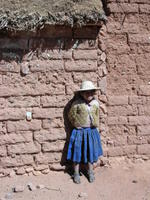 Wednesday
WednesdayAfter braving the morning cold and frozen water, we left the little town of Macha and went along the rocky dusty road to another pueblito to meet some of the PCI technicians and visit some more schools.Most of the schools in the area were on vacation, but we were still able to talk to some of the PTA members responsible for preparing the school breakfast.Most of the teachers live in bigger towns and only come during the week. The most interesting part of this day was a visit to a very remote and high village to examine their school, which was a good change from visiting only the schools that were closer to main roads. This was probably one of the poorest areas in Bolivia: it takes about 5 hours walking to get to the nearest town; barely anyone speaks Spanish, and the people seem to be completely isolated from what we call civilization.It was definitely good to know that PCI works in such areas and has had success (most of the technicians that work in this municipality speak Quechua).We visited some more towns located in different spots along an incredibly winding and narrow mountain road. The scenery along the way was truly breathtaking...no camera could ever capture it.Upon arrival back to Oruro, I opted not to spend the night there and took a bus back to La Paz.

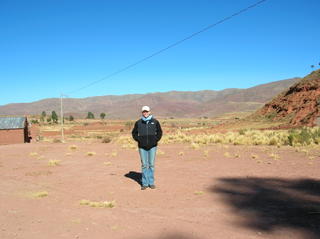
Trip to the altiplano (contd)
 Tuesday
TuesdayEarly in the morning we embarked on our journey to the campo (villages) to visit the schools, examine their school breakfast program, and encourage the technicians that work in those remote areas.This area of Bolivia is very different from the tropics...most of the roads aren't paved (no coca plantations=less US funds), the climate is very cold and dry, and there is barely any electricity and water.There, I was not only able to see the real poverty and hardship that people face...the schools were small, without heat, the children were timid and covered in dirt, and barely anyone spoke Spanish (most people spoke Quechua, one of the main indigenous languages).Again, I felt like I took an intensive course in International Development while observing what the PCI technicians do and how humbly they live among the people they work with.They travel on motorcycles along the dusty and rocky roads all day visiting schools, instructing parents and teachers about health and nutrition, and changing attitudes towards education.I was definitely only a development "tourist" (straight out of Chamber's book for those who know his writing) driving around in a nice SUV and seeing the success of a development project that took months and months of hard work to achieve.
One of the best parts of the trip was finally seeing the animals that I have read so much about...the llamas.They are definitely unique creatures, shy, but friendly, and have an adorable face.They survive where it's driests and coldrest, and where sheep and cows don't do very well.PCI has a project to strenghten the llama owners by teaching them how to build corals where the animals would be safe from the wind and wolves. We visited one of those corals where the little kids helped me hold a llama.The thing that amazed me most is that those people were poor and barely spoke Spanish, but were so extremely kind and eager to please a stranger (me).
When I said that I stayed in a rather rustic hotel in the tropics, I didn't really understand the meaning of rustic.That night we stayed in a cold mountaneous pueblito (small town) with a small tap with cold water, a latrine, and a thin wall separating me from the frost of the night.I did survive that one night, but couldn't stop thinking about how people have to face these rough conditions their whole lives.

Trip to the tropics (continued)


 Wednesday
WednesdayWe went to a local agricultural coop in the morning to see if there is a possibility that PCI would buy some of the stuff they produce for our school breakfast program.Definitely important to mention that this area of Bolivia is famous for its coca plant production, and the US government has spent millions of dollars in the area to curb the coca plantations.Everywhere you looked, there was an USAID sign of another project, and the main road was nicer than some of the roads in DC.The coop we met with was one of the organizations that was initially supported by the USAID and since has become a successful producer of local grains and vegetables.
After this meeting we met with the town's mayor in his office to talk to him about what PCI does and ensure his continued support.He seemed very enthusiastic about making educational investment a priority.Needless to say, I was learning soo much during all these meetings, beginning to understand how hard development work really is.After visiting some more schools in the area and feasting on the best bananas and oranges Ive ever had, we embarked on our long journey back to Cochabamba.
Another interesting tidbit about Bolivia...roadblocks seem to be the answer to any problem.When we were leaving Cocha on Monday, we barely missed the beginning of a roadblock.When we were coming back from Chapare (the tropics), we were not sure if we would be able to get back to the city and were trying to figure out a way to get through (there is only one road from Chapare to Cocha).Praise the Lord, the roadblockade was lifted earlier that day, but it had created an enormous congestion of traffic (mostly trucks and buses).This, in addition to the thickest mountain fog I have ever witnessed, has made our trip last for 6 hours instead of the usual 4.
The best part though...we stopped by a national park for about 30 minutes and went to a monkey area.It was truly one of the best experiences of my life...the little monkeys could approach you, get on your shoulders, you could hold them and play with them...they were soo gentle and sweet, like little babies.The only thing is that they are pretty mischievous and almost took away my hat. There is a warning that you cannot have anything in your pockets or in your hands; the monkeys even know how to unzip the pockets.Still, they were amazingly cute and precious.
Trip to the tropics (continued)
 Tuesday
TuesdayOn Tuesday we left for the actual tropics early in the morning..there were 5 of us in a small pick-up truck going up and down windy mountain roads, climbing and descending again.It was amazing to see how the scenery changes almost visibly: at first you see dry mountain ranges, and then they mountains get green and covered by all sorts of tropical flora...you could even hear the monkies screaming in the woods.And when you hear about the dirt roads in developing countries, trust me the rumors are true...this was a pretty major road connecting two big regions in Bolivia, and some parts of it were made of rocks and dirt, which made it a very interesting drive to say the least.
Upon arrival to the villages, we visited 2 schools where PCI distributes school breakfast.This is where I was really able to see development professionals in action.All the stuff we learn in class in grad school was all there.At one of the schools, one of the technicians was having an informational meeting with the parents about the need and the way to disinfect drinking water. We were mainly checking up on how the food is being stored, cooked, and distributed among the children.
At night, I stayed in some type of bed-n-breakfast housing, which was run by a lady as an microenterprise venture with the help of WLO. As I have discovered, the tropics are full of bugs of large sizes, so needless to say, I Raided my room very carefully before sleeping.Those who know me well enough will be proud of me: the conditions at that place were pretty rustic,but I survived with good attitude.
The trip to the tropics

Ok, Im finally back to civilization and since Im in bed recovering from an upset stomach caused either by something I ate or the altitude, I have time to write a lot.The past few days have been really eyeopening in many ways. So here is the day-by-day account of my trip.
MondayThe bus ride to Cochabamba was really long (7 hours), and the bus kept stopping to pick up more people even though there were no seats.I wasn't bored by any means though...looking out of the window to see the changing scenery kept me occupied the whole time.I think Bolivia is the only country where in the span of 7 hours you can see the mountain ranges, the altiplano (mountain valleys), and the tropics.To get to Cochabamba,we had to climb over the Andes even higher than La Paz, and then go down on a fairly narrow and curvy mountain road.(For those who are interested: La Paz is between 3300-3800 meters above the sealevel, then we climbed over some mountain ranges to about 4000 meters, and then descended to about 2300).Needless to say, you can definitely feel the altitude change in your body. Upon the arrival to Cochabamba, I was immediately welcomed by the warm valley sun. After meeting the PCI people in this regional office, I was put in a nice hotel ($20!!) and watched cable TV all night. Cochabamba is famous for its big statue of Christ on top of the hill...I had a perfect view of it from my hotel balcony.
Off to the tropics!
So tomorrow Im taking a bus, by myself, to Cochabamba, which is another major city in Bolivia and is a lot warmer since it is a lot lower, and then on Tuesday and Wednesday Im going to the real tropics with my coworkers to visit some of the schools where Project Concern works.Im excited about being in some warmer weather and seeing the real tropics.Those who know me well would be really proud of me...Im only taking a big backpack on this 3 day trip!!!(definitely not the way I usually travel).I have been given all sorts of warning such as don't talk to anybody, don't eat anything that is offered to you, and don't sleep on the bus (6-7 hour ride)...Even though Im taking all these warnings seriously, how good it is to know that Im under the protection of the sovereign God!




















